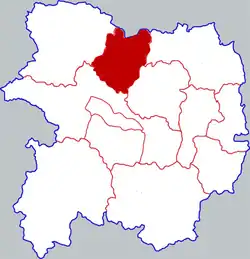Qianyang County
千阳县 Kienyang | |
|---|---|
 Qianyang in Baoji | |
.png.webp) Baoji in Shaanxi | |
| Country | People's Republic of China |
| Province | Shaanxi |
| Prefecture-level city | Baoji |
| Area | |
| • Total | 993.93 km2 (383.76 sq mi) |
| Highest elevation | 1,545.5 m (5,070.5 ft) |
| Lowest elevation | 710 m (2,330 ft) |
| Population (2019) | |
| • Total | 125,400 |
| • Density | 130/km2 (330/sq mi) |
| Time zone | UTC+8 (China standard time) |
| Postal code | 721100 |
| Licence plates | 陕C |
| Website | www |
Qianyang County (simplified Chinese: 千阳县; traditional Chinese: 千陽縣; pinyin: Qiānyáng Xiàn) is a county in the west of Shaanxi province, China, bordering Gansu province to the north. It is under the administration of the prefecture-level city of Baoji.
Established in 570 as 汧陽 (also pronounced Qianyang), in October 1964, in order to avoid rare characters, the name was changed to its current writing. Since then, where the name of the place is "Shaanxi", all use "Qian".[1]
Qianyang is considered the birthplace of Qin culture and is noted for its folk embroidery.[2]
Administrative divisions
As 2020, this county is divided into seven towns.[3]
- Towns
|
|
Climate
| Climate data for Qianyang (1991–2020 normals, extremes 1981–2010) | |||||||||||||
|---|---|---|---|---|---|---|---|---|---|---|---|---|---|
| Month | Jan | Feb | Mar | Apr | May | Jun | Jul | Aug | Sep | Oct | Nov | Dec | Year |
| Record high °C (°F) | 18.7 (65.7) |
23.7 (74.7) |
28.8 (83.8) |
34.9 (94.8) |
36.4 (97.5) |
40.1 (104.2) |
40.0 (104.0) |
37.8 (100.0) |
40.3 (104.5) |
31.0 (87.8) |
25.2 (77.4) |
19.6 (67.3) |
40.3 (104.5) |
| Mean daily maximum °C (°F) | 5.1 (41.2) |
8.7 (47.7) |
14.7 (58.5) |
21.1 (70.0) |
25.5 (77.9) |
29.9 (85.8) |
31.0 (87.8) |
28.8 (83.8) |
23.6 (74.5) |
18.1 (64.6) |
12.2 (54.0) |
6.5 (43.7) |
18.8 (65.8) |
| Daily mean °C (°F) | −1.6 (29.1) |
2.0 (35.6) |
7.5 (45.5) |
13.4 (56.1) |
17.8 (64.0) |
22.5 (72.5) |
24.7 (76.5) |
23.0 (73.4) |
18.0 (64.4) |
12.1 (53.8) |
5.5 (41.9) |
−0.3 (31.5) |
12.0 (53.7) |
| Mean daily minimum °C (°F) | −6.2 (20.8) |
−2.7 (27.1) |
2.1 (35.8) |
7.1 (44.8) |
11.4 (52.5) |
16.3 (61.3) |
19.6 (67.3) |
18.9 (66.0) |
14.2 (57.6) |
7.9 (46.2) |
1.0 (33.8) |
−4.7 (23.5) |
7.1 (44.7) |
| Record low °C (°F) | −16.5 (2.3) |
−14.4 (6.1) |
−7.9 (17.8) |
−3.5 (25.7) |
1.2 (34.2) |
8.0 (46.4) |
12.6 (54.7) |
10.2 (50.4) |
4.5 (40.1) |
−3.0 (26.6) |
−11.6 (11.1) |
−20.7 (−5.3) |
−20.7 (−5.3) |
| Average precipitation mm (inches) | 6.3 (0.25) |
8.5 (0.33) |
21.1 (0.83) |
35.8 (1.41) |
56.5 (2.22) |
66.7 (2.63) |
105.9 (4.17) |
114.5 (4.51) |
102.4 (4.03) |
49.2 (1.94) |
15.6 (0.61) |
4.0 (0.16) |
586.5 (23.09) |
| Average precipitation days (≥ 0.1 mm) | 4.2 | 5.1 | 7.2 | 7.5 | 10.8 | 10.3 | 10.6 | 11.6 | 12.8 | 10.7 | 6.0 | 2.9 | 99.7 |
| Average snowy days | 6.1 | 5.4 | 2.3 | 0.2 | 0 | 0 | 0 | 0 | 0 | 0 | 1.8 | 3.7 | 19.5 |
| Average relative humidity (%) | 61 | 63 | 63 | 65 | 68 | 68 | 74 | 80 | 83 | 80 | 74 | 65 | 70 |
| Mean monthly sunshine hours | 140.4 | 131.9 | 165.8 | 193.5 | 206.4 | 205.2 | 202.5 | 169.8 | 129.4 | 130.5 | 139.0 | 146.8 | 1,961.2 |
| Percent possible sunshine | 45 | 42 | 44 | 49 | 48 | 48 | 46 | 41 | 35 | 38 | 45 | 48 | 44 |
| Source: China Meteorological Administration[4][5] | |||||||||||||
References
- ↑ "宝鸡市地名由来及历史沿革". www.longxian.gov.cn. 陇县人民政府. 2017-03-22. Archived from the original on 2020-03-21. Retrieved 2020-03-21.
- ↑ Zhou, Jun; Taylor, Gail (2019-01-17). The Language of Color in China. Cambridge Scholars Publishing. ISBN 978-1-5275-2616-7.
- ↑ 2020年统计用区划代码(千阳县) (in Chinese). National Bureau of Statistics of China. 2020. Archived from the original on 2020-11-29. Retrieved 2020-12-31.
- ↑ 中国气象数据网 – WeatherBk Data (in Simplified Chinese). China Meteorological Administration. Retrieved 26 August 2023.
- ↑ 中国气象数据网 (in Simplified Chinese). China Meteorological Administration. Retrieved 26 August 2023.
34°45′46″N 107°12′15″E / 34.76278°N 107.20417°E
This article is issued from Wikipedia. The text is licensed under Creative Commons - Attribution - Sharealike. Additional terms may apply for the media files.